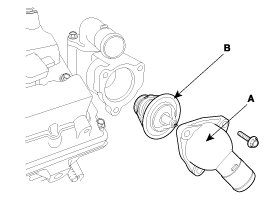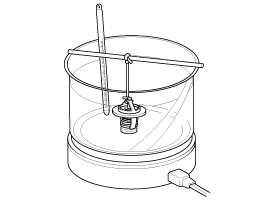Kia Cadenza: Cooling System / Thermostat Repair procedures
Kia Cadenza YG 2016-2025 Service Manual / Engine Mechanical System / Cooling System / Thermostat Repair procedures
| Removal |
Removal of the thermostat would have an adverse effect,
causing a lowering of cooling efficiency. Do not remove the thermostat,
even if the engine tends to overheat. |
| 1. |
Drain engine coolant so its level is below thermostat.
(Refer to Cooling System - "Coolant") |
| 2. |
Disconnect the ratiator lower hose (A).
(Refer to Cooling System - "Radiator Hose") |
| 3. |
Remove the water inlet fitting (A) and the thermostat (B).
|
| Inspection |
| 1. |
Immerse thermostat in water heated to over 95°C (203°F), then heat for at least 3 minutes to check valve lift.
|
| 2. |
Check the valve opening temperature.
If the valve opening temperature is not as specified, replace the thermostat. |
| 3. |
Check the valve lift.
If the valve lift is not as specified, replace the thermostat. |
| Installation |
| 1. |
Place the thermostat in thermostat housing.
|
| 2. |
Install the water inlet fitting (A).
|
| 3. |
Connect the ratiator lower hose (A).
|
| 4. |
Install the ratiator upper hose.
(Refer to Cooling System - "Radiator Hose") |
| 5. |
Fill with engine coolant. |
| 6. |
Start engine and check for leaks. |
 Thermostat Components and Components Location
Thermostat Components and Components Location
Components
1. Water temperature control assembly2. Thermostat3. Water inlet fitting pipe
...
 Thermostat Troubleshooting
Thermostat Troubleshooting
Troubleshooting
SymptomsPossible CausesRemedyCoolant leakage
•
From the thermostat gasket
Check the mounting bolts
•
Check the torque of the mounting bolts
•
Reti ...
Other information:
Kia Cadenza YG 2016-2025 Service Manual: Crash Pad Components and Components Location
Components 1. Main crash pad assembly2. Crash pad side cover3. Side airvent duct4. Crash pad garnish (LH)5. Cluster fascia panel6. Shroud upper panel7. Shroud lower panel8. Crash pad center garnish9. Ignition key grommet10. Crash pad lower panel11. Reinforcing panel12. Center facia upper panel1 ...
Kia Cadenza YG 2016-2025 Service Manual: Schematic Diagrams
MDPS Circuit Diagram Harness Connector TypePin NoDescriptionBattery1Battery +2Battery -Vehicle1IGN2-3-4-5-6-7High_CAN8Low_CAN ...
Copyright © www.kcadenzavg.com 2017-2025





